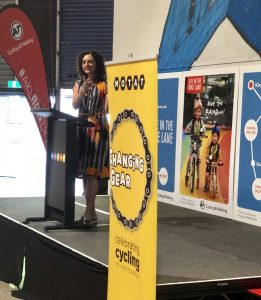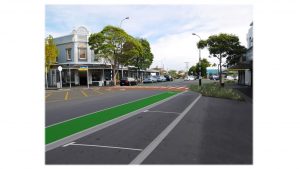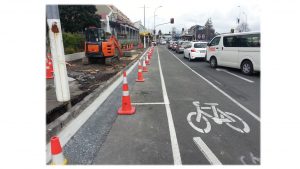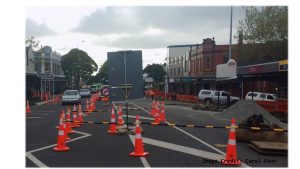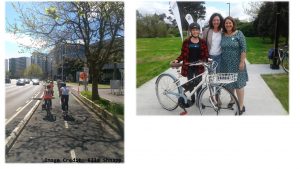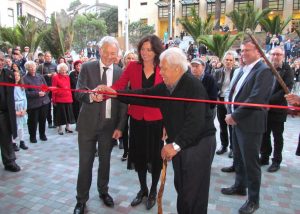This report covers the period 12 February until 12 March 2018. This report is on the agenda of the Board’s March business meeting.

Highlights
Have your say month
A massive Council “Have your Say” month of consultation got underway on 28 February. This is the opportunity every three years to look in depth at Auckland’s 10-year budget. As part of this budget cycle local priorities for the next financial year 18/19 are also up for discussion.
Over the month the Board is hosting two public meetings, a hearing and four pop in sessions at local libraries (my own summary of the consultation)
We hosted the first international delegation to visit Waitemata Local Board on 28 February. Hon Andrew Solomon Napuat Minister of Internal Affairs, Mrs Cherol Alanavibori Director General, Ministry of Internal Affairs and Mr Edward Kaltamat Director of Local Authorities from Vanuatu discussed local planning, funding and community engagement with board members.
Transport projects:
Karangahape Road Enhancement Project
The board has confirmed our strong support for this project to proceed.
 We have however raised our concerns regarding the development response and project communications. We received reassurances that this joint AT and Auckland Council (with additional government funding) is being coordinated by the Development Programme Office (DPO) including the development response. This will see to the planning, development and communication on the numerous projects in the precinct managed in a holistic way
We have however raised our concerns regarding the development response and project communications. We received reassurances that this joint AT and Auckland Council (with additional government funding) is being coordinated by the Development Programme Office (DPO) including the development response. This will see to the planning, development and communication on the numerous projects in the precinct managed in a holistic way
The project team has now taken steps to progress a development response action plan with the K’road business association and to ensure the project is successfully delivered with minimal business disruption. Construction is due to start on this transformational and long awaited project at the end of 2018. The latest update is available on AT’s website.
Consultation on a parking plan to maximise parking options in and around Karangahape Road once the enhancements project is complete is currently under consultation until 1 April. It looks to maximise parking availability and turnover by prioritising short stay parking and loading zone access in peak time.
AT has confirmed the following parking changes are proposed.
| Number of on-street car parks currently | Number of on-street car parks post-project | |
| Off-peak hours | 501 | 483 |
| Peak hours | 485 | 416 |
| Number of loading zones currently | Number of loading zones post-project | |
| Off-peak hours | 55 | 62 |
| Peak hours | 52 | 44 |
In addition, the parking plan has highlighted the opportunities for improving turnover of 70 existing car parks that are currently unrestricted and 53 car parks in an AT controlled car park on Upper Queen Street.
A parking plan (currently under consultation) to ensure the effective management of the available parking together with a package of assistance should respond to retailer concerns and allow the project to progress with the welcomed support from the KBA.
Waitemata Safe Routes update
Community Liaison Group meetings for the Richmond Road and Garnet Road routes got underway on 12 February. Both meetings were very well attended and the new process to review the design positively supported by the majority of attendees. The Community Liaison Groups have been established to:
- Ensure that those organisations or groups with an interest in the project are involved in its development
- Ensure the project accurately reflects community aspirations and delivers established objectives and design principles
I am the board’s representative on both groups. Member Rob Thomas is also on the Garnet Road CLG.
Franklin Road upgrade
 At the community liaison group meeting on 13 March Auckland Transport provided an update on progress so far:
At the community liaison group meeting on 13 March Auckland Transport provided an update on progress so far:
Drainage:-
- 20 New stormwater manholes installed
- 40 New stormwater catch pits installed
- 440m of new Stormwater main installed in the middle of the road
- 350m of new catch pit leads installed
Vector ducting complete. New cabling installation in progress.
The new Wellington St/England St roundabout is expected to be completed in April 2018 (photo right). The design is the first of its kind in Auckland to incorporate traffic calming, cyclelanes, high quality materials and street greening. The project has an overall competition target of mid 2019. More project details on the AT website.
Further transport updates are available on the AT monthly report to the board.
Western Springs Native bush regeneration project
 The Waitemata Local Board has a long standing community project to regenerate an area of native bush in Western Springs with improved tracks for bush walks. The consistent advice we’ve received is that before any track work can be undertaken the 80 year old pine stand behind the zoo needs to be removed because the trees are failing and pose a risk.
The Waitemata Local Board has a long standing community project to regenerate an area of native bush in Western Springs with improved tracks for bush walks. The consistent advice we’ve received is that before any track work can be undertaken the 80 year old pine stand behind the zoo needs to be removed because the trees are failing and pose a risk.
Details of the project are being finalised and will be made publicly available shortly (there will also be consultation on the planting and track design) but I recently provided an update via Facebook because I received a complaint on 2 March that Council was committing “eco rape” by felling one of the pine trees. The Council arborist advised the work involved removal of a hazardous and 90% dead pine tree. The Council arborist logged this following a regular monthly inspection and organised the immediate removal without referring it to the board. The arborist has confirmed that the trees are well beyond their 80-year life expectancy and are declining rapidly with regular branch and whole tree failure occurring.
Regular maintenance and occasional removal of unstable trees is required for safety reasons with no viable alternative. The recent incident in Rotorua involving the failure of a tree that resulted in a death has highlighted the need to respond appropriately to recognized risks.
I am also advised that it is considered unlikely (as claimed by the complainant) that white-faced heron nest in the pines given the general lack of foliage and exposed nature of the trees. Tree works are generally only scheduled outside the nesting season unless required for safety reasons
Maintenance
 Last month I reported on issues with the poor standard of maintenance that needs to be addressed in Waitemata.
Last month I reported on issues with the poor standard of maintenance that needs to be addressed in Waitemata.
Community Facilities has also undertaken to address the weeds in Rose Road Gully. (Photo right board member Adriana Christie attacks the weeds that are strangling native trees)
Emergency preparedness
Following the Emergency Preparedness workshop held on the 31 January at the Waitematā Local board office, a Waitematā Facilities Network workshop was held on 22 February to explore what facilities can contribute and what is needed as part of this network.
The outcome we are hoping to achieve from a Facilities Network in Waitematā is to empower our communities to enhance resilience to disasters and the impact of climate change:
- Support educational programmes to prepare our communities for disasters and the impact of climate change
- Identify key locations in our community as civil defence information centres
Meetings and workshops: 12 February until 13 March 2018
- Weekly chair’s meeting held every Monday with the local board services team
- Board all day workshops on 13, 27 February and 6, 13 March
- Parnell Plan working group meetings on 12 February and 12 March
- Chair’s Forum on 12 February and 12 March
- Ponsonby Business Association committee meetings held on 13 February and 13 March
- Domain Committee agenda run through meeting on 13 February
- Trafinz Executive Committee meeting on 14 February
- Monthly comms update meeting on 14 February
- Domain committee walking tour and business meeting held in Parnell on 14 February
- Grey Lynn business Association committee meeting on 15 February
- Heart of the City annual results presentation to local board members by Viv Beck, CEO on 15 February.
- Meeting on 16 February with Westfield, Newmarket Business Association, Auckland Transport, and Development Programme Office representatives to discuss potential upgrade of Nuffield Street
- Community Reference Group meetings for Garnet Road and Richmond Road held at Auckland Transport on 16 February
- Regional local board cluster workshop on 19 February
- Local board business meeting on 20 February
- Waitemata Facilities Network (Emergency Management) Workshop on 21 February at Ellen Melville Centre
- Grey Lynn Park Multipurpose Facility Briefing on 21 February
- Auckland Domain bus service briefing by Auckland Transport for the Domain committee and board members on 21 February
 Attended the governing body meeting on 22 February at the Town Hall for the swearing in of Councillor Josephine Bartley (photo right)
Attended the governing body meeting on 22 February at the Town Hall for the swearing in of Councillor Josephine Bartley (photo right)- Inner City Network Meeting on 22 February
- Franklin Road lights debrief meeting on 23 February
- Meeting on 23 February with the board’s engagement adviser to discuss the 10 year budget consultation
- Catch up with Barbara Ward and Therese Colgan, Mt Albert Electorate Office on 23 February
- LGNZ Governance & Strategy Advisory Group meeting in Wellington on 26 February
- LGNZ roadshow briefing to local board members on 28 February
- Hosted the Vanuatu delegation at the board office on 28 February
- Meeting with Italian festival organiser on 28 February
- Morning tea for the departing Board’s engagement adviser
- Meeting with Derek Handley, sponsor of Active Citizen on 1 March
- Comms meeting on 1 March
- Tour of the Auckland City Mission premises at 140 Hobson Street on 1 March and presentation on their project Mission HomeGround
- LGNZ Zone 1 meeting at the Town Hall on 2 March
- Leadership for Chairs programme: Session two on 5 March
- Meeting with the Herne Bay Residents Association on 9 March
- Local Board briefing by Healthy Waters on 35 year stormwater discharge consents
- Victoria Quarter transformation meeting with representative from Sugar Tree apartments on 9 March
- Franklin Road Community Reference Group meeting at Auckland Transport on 13 March
Events and functions: 12 February until 13 March 2018
 Go by Bike Day on 14 February at Silo Park (coffee and muffin provided by Auckland Transport)
Go by Bike Day on 14 February at Silo Park (coffee and muffin provided by Auckland Transport)- Opening of Pā Rongorongo – Citizens Information Hub at Griffith Gardens on 15 February (photo right the Mayor cutting the ribbon)
- YMCA Auckland City Stadium Re-Opening on 15 February
- Grey Lynn Business Association networking drinks on 15 February
- Spoke at the Bike to the Future bike ride and petition presentation to Auckland Transport organised by Generation Zero on 17 February (photo right)
- By-election day on 17 February celebrated the successful election of City Vision’s Denise Roche (photo below)
- Celebrated Pride Parade on Ponsonby Road in the Glamstand at the invitation of the Pride Trust on 17 February
 Attended Myers Park Medley hosted by the Waitemata Local Board on 18 February
Attended Myers Park Medley hosted by the Waitemata Local Board on 18 February- Opening of the Fringe Festival on 19 February
- Auckland Foundation function on 21 February with guest speaker Celia Caughey, City Mission Trustee
- New Zealander of the Year Awards dinner on 22 February at the invitation of the University of Auckland
- Joined mana whenua and Cr Desley Simpson for the pouwhiri at the opening of the Volvo Ocean Race Village on 24 February
- Repair Café hosted by Grey Lynn 2030 at Westerns Springs Community Hall on 24 February
 Waireka Festival and tour of the Sanctuary Gardens at Unitec on 24 February
Waireka Festival and tour of the Sanctuary Gardens at Unitec on 24 February- Japan Festival Opening at Shed 10 on 25 February
- Officiated at the Citizenship Ceremony at the Town Hall on 28 February
- Opening of the Lantern Festival on 28 February at the Auckland Domain (photo right)
- Opening of the Auckland Arts Festival Playground festival garden at Silo Park on 7 March
- International Womens Day breakfast hosted by Central City Library to watch livestreamed directly from Parliament in Wellington (hosted by the Minister for Women, Julie-Anne Genter), keynote speakers include Governor General Dame Patsy Reddy and former Prime Minister Helen Clark, in a conversation with Dr Gill Greer, Chief Executive of the National Council for Women.
- Speaker at Zonta’s International Womens Day celebration at Ellen Melville Centre on 8 March
- Eru Dangerspiel at the Playground, Silo Park at the invitation of the Auckland Arts Festival on 8 March
10 year budget consultation events
 Presented to the Inner City Network Meeting on 22 February
Presented to the Inner City Network Meeting on 22 February- Gave a presentation to Parnell Rotary’s breakfast meeting on 28 February
- Attended Auckland Conversations: Transport on 28 February Bernard Hickey was joined by Auckland Mayor Phil Goff and a panel of industry experts to discuss and debate Auckland’s transport challenges and the potential solutions available.
- Attended the Pasifika fono at Western Springs Community Hall on 5 March
- Presented at the Grey Lynn public meeting hosted by the Board with the Grey Lynn Residents’ Association on 8 March
- Radio Interview with Julie Fairey on Red Alert Radio on the topic of the 10 year budget
- Presented to the Grafton Residents Association monthly meeting on 12 March

























